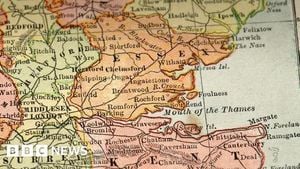Recent advancements at the ISIS facility have resulted in new neutron detectors aimed at enhancing the capabilities of spin-echo small-angle neutron scattering (SESANS) techniques. These innovations address the nuanced demands of neutron experiments, allowing researchers to probe materials more effectively across various scales.
Neutron spin-echo spectroscopy, which offers high energy resolution, traditionally faced limitations due to reduced neutron flux. Standard scattering instruments typically capture structures on the nanometer scale (10-200 nm), but SESANS methods extend this reach to encompass larger structures, measuring from tens of nanometers to micrometers.
At the heart of this development are two distinct detectors: the position-sensitive ZnS:Ag/6LiF scintillator-based detector and the multi-strip GS20 glass scintillator detector. Both designs cater to specific experimental needs, optimizing neutron detection capabilities to fulfill the science-driven high-performance demands.
The ZnS:Ag/6LiF detector incorporates wavelength shifting fibers (WLSF) to achieve spatial sampling requirements of less than 0.5 mm and is engineered to fit within the tight geometrical constraints of the Larmor instrument. This innovative detector design allows for high incident neutron flux, promising greater signal detection with reduced background noise. Gamma sensitivity measurements indicate its capability to achieve levels below 10^-6, significantly outpacing traditional detectors.
Simultaneously, the GS20 glass scintillator detector was developed to meet the challenges posed by higher neutron fluxes encountered during SESANS experiments. Initial results show it can handle peak rates up to 300 kcps, effectively boosting the experimental speed and enhancing data quality. Its efficiency measured at 75% for thermal neutrons at the 2 Å wavelength showcases its potential for higher accuracy and advanced statistical analysis.
These detectors were rigorously tested at the ISIS neutron detector test facility, with various characterizations assessing their performance against gamma sensitivity, neutron detection efficiency, and count rate capability.
Sensitivity to gamma radiation, which can overshadow neutron signals, was evaluated using controlled gamma sources. Measurements established the efficacy of both detectors, with the GS20 achieving notable gamma sensitivity levels of 3 x 10^-4—well within the project's specifications.
The significant increase in count rate capability, especially with the GS20, allows researchers to push the boundaries of SESANS experiments and perform more accurate ambient measurements. This development is expected to facilitate the exploration of more complex systems, advancing the frontiers of materials research.
Future efforts will focus on optimizing the signal-processing technologies employed by the WLSF ZnS:Ag/6LiF detectors, aiming to refine their count rate capabilities even more. There are also plans to incorporate real-time data processing algorithms, which could dramatically improve performance and reliability during experimental setups.
With these innovative detectors now routinely employed at ISIS, the potential for breakthroughs across various material sciences grows increasingly promising. The integration of these technologies marks a significant leap forward for neutron scattering, aligning perfectly with the increasing demands for higher resolutions and faster exploratory capabilities. This advancement not only sets the stage for enhanced experimentation on existing materials but also opens new avenues for investigating the fundamental properties of complex structures.



